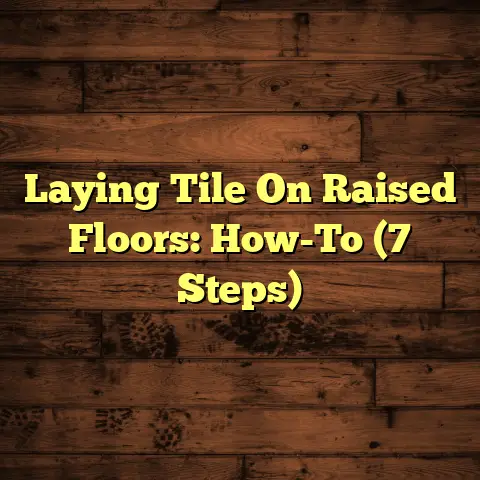Average Cost To Tile A Floor? (4 Factors!)
Introduction: The Essential Guide to Flooring Investment
Let’s talk about flooring. As a flooring contractor, I’ve seen it all.Flooring is a big deal. It sets the tone for your home, adds value, and, let’s be real, it’s what you walk on every day!
Tiling is a fantastic choice. It’s durable, looks great, and can really elevate a space.
But, how much does it actually cost to tile a floor? That’s the million-dollar question, right?
The price can vary quite a bit. It depends on a bunch of things. Don’t worry, I’m here to break it down for you.
In this guide, we’ll dive into the four biggest factors that impact the cost of tiling a floor. By the end, you’ll have a much clearer picture of what to expect. Let’s get started!
Section 1: The Cost of Materials – What You Need to Know
Okay, let’s kick things off with materials. This is a big chunk of the overall cost, so pay close attention.
1.1 Types of Tiles
First up, the tiles themselves. There are so many options! Ceramic, porcelain, natural stone, glass, even metal!
-
Ceramic: Your budget-friendly option. Expect to pay around $0.50 to $5 per square foot. Great for bathrooms and kitchens.
-
Porcelain: More durable than ceramic, and often more stylish. Prices range from $3 to $10 per square foot.
-
Natural Stone: Think granite, marble, slate. These are high-end and can cost anywhere from $5 to $50+ per square foot.
-
Glass: Beautiful, but pricey and can be tricky to install. Expect to pay $8 to $30 per square foot.
The price differences are huge, right? Choosing the right material can significantly impact your budget.
1.2 Quality vs. Cost
Now, let’s talk quality. It’s tempting to go for the cheapest option, but trust me, it’s not always the best idea.
Cheaper tiles might chip easily, fade, or just not look as good. Investing in higher-quality tiles means they’ll last longer and look better.
Think of it this way: a cheap tile might cost $1 per square foot, but it could need replacing in a few years.
A higher-quality tile might cost $5 per square foot, but it could last for decades.
I’ve seen homeowners try to save money upfront, only to regret it later. It’s worth spending a bit more for quality.
1.3 Tile Size and Thickness
Tile size and thickness also play a role in cost. Larger tiles often cost more per tile, but they can cover more area quickly.
Thicker tiles are generally more durable and can handle more weight. They’re also often more expensive.
For example, a standard 12×12 inch ceramic tile might cost $2 per square foot. A 24×24 inch tile of the same material might cost $4 per square foot.
It might seem like the larger tile is more expensive, but you’ll need fewer of them to cover the same area!
1.4 Additional Materials
Don’t forget about the extras! You’ll need underlayment, adhesives (thin-set mortar), grout, and sealers.
-
Underlayment: This goes under the tile to provide a smooth, stable surface. Costs range from $0.50 to $3 per square foot.
-
Thin-Set Mortar: The “glue” that holds the tiles in place. Expect to pay around $10 to $30 per bag.
-
Grout: Fills the spaces between the tiles. Prices vary depending on the type and color, but budget around $15 to $50 per bag.
-
Sealer: Protects the grout from stains and moisture. Costs around $10 to $30 per bottle.
These costs can add up quickly, so be sure to factor them into your budget. I always recommend buying a little extra of everything, just in case.
Section 2: Labor Costs – The Hidden Expense
Alright, let’s talk about labor. This is often the “hidden” expense that people don’t fully consider.
2.1 The Importance of Professional Installation
DIY tiling can be tempting, but trust me, it’s not as easy as it looks. I’ve seen some DIY disasters!
A professional installer has the experience, tools, and knowledge to do the job right.
They’ll ensure the tiles are level, properly spaced, and that the grout is applied correctly.
Plus, many professional installers offer warranties. If something goes wrong, they’ll fix it.
Labor costs can range from $4 to $15+ per square foot. It depends on the complexity of the job and the experience of the installer.
Is it worth it? In my opinion, absolutely. A bad tile job can be a nightmare to fix.
2.2 Regional Variations in Labor Costs
Labor costs vary widely depending on where you live. Big cities like New York or San Francisco will have higher rates than smaller towns.
For example, in a major metropolitan area, you might pay $12-$15 per square foot for labor.
In a smaller town, you might only pay $6-$8 per square foot.
It’s always a good idea to get quotes from several local contractors to get a sense of the going rate in your area.
2.3 Complexity of the Job
The complexity of the job also affects labor costs. A simple square room is much easier to tile than a bathroom with lots of angles and fixtures.
Intricate tile patterns, like herringbone or mosaic, will also increase labor costs.
Subfloor conditions are another factor. If the subfloor is uneven or damaged, it will need to be repaired before tiling, which adds to the cost.
I always tell my clients to be prepared for unexpected issues. Sometimes, you don’t know what’s lurking under the old flooring until you tear it up.
2.4 Additional Services
Finally, be aware of additional services that may incur extra charges.
-
Removal of Old Flooring: This can cost anywhere from $1 to $5 per square foot.
-
Subfloor Leveling: If the subfloor is uneven, leveling it can add $2 to $5 per square foot.
-
Custom Designs: Intricate patterns or custom borders will increase labor costs significantly.
-
Moving Furniture: Some contractors charge extra to move furniture.
Make sure you get a detailed quote that includes all of these potential costs.
Section 3: Area Size – The Scale of Your Project Matters
Okay, let’s talk about size! The bigger the area, the more you’ll spend, right? But there are some nuances to consider.
3.1 Measuring Your Space
Accurate measurements are crucial. You don’t want to buy too little tile, or too much!
Measure the length and width of the room in feet. Multiply those numbers to get the square footage.
For example, if a room is 10 feet long and 12 feet wide, the square footage is 120 square feet.
Always add extra, I recommend at least 10%, to account for cuts, waste, and future repairs.
So, for a 120 square foot room, I’d buy at least 132 square feet of tile.
3.2 Cost Per Square Foot
The cost per square foot is a key metric. It’s the total cost of materials and labor divided by the square footage of the area.
For example, let’s say you’re using ceramic tile that costs $3 per square foot, and labor costs are $6 per square foot.
Your total cost per square foot would be $9.
This is a great way to compare different tile options and contractors.
3.3 Bulk Pricing
Larger projects may qualify for bulk pricing. Some tile suppliers offer discounts if you buy a certain quantity of tile.
It’s always worth asking if there are any discounts available. You might be surprised!
Even a small discount can save you a significant amount of money on a large project.
3.4 Calculating Total Costs
Okay, let’s put it all together. Here’s a simple formula to calculate your projected costs:
- Square Footage of Area x (Cost of Tile Per Square Foot + Labor Cost Per Square Foot) = Total Cost
For example, let’s say you’re tiling a 150 square foot bathroom with porcelain tile that costs $5 per square foot, and labor costs are $8 per square foot.
- 150 x ($5 + $8) = $1950
So, your estimated total cost would be $1950. Don’t forget to add extra for underlayment, grout, and other materials!
Section 4: Additional Factors Influencing Costs
Alright, we’re almost there! Let’s cover a few more factors that can influence the cost of tiling a floor.
4.1 Design Elements
Intricate designs, patterns, and border tiles can add a lot of visual appeal, but they also add to the cost.
Herringbone, chevron, and mosaic patterns require more cuts and more labor, which increases the overall cost.
Border tiles, especially those made of natural stone or glass, can also be quite expensive.
I always advise my clients to weigh the aesthetic benefits against the added cost. Sometimes, a simpler design can be just as beautiful and more budget-friendly.
4.2 Seasonal Considerations
Believe it or not, the time of year can affect pricing. Contractors are often busier in the spring and summer, which can drive up labor costs.
Also, some materials may be more difficult to find or more expensive during certain times of the year.
For example, natural stone tiles may be more expensive in the winter if quarries are closed due to weather.
If you have some flexibility, consider scheduling your tiling project during the off-season. You might be able to save some money.
4.3 Maintenance and Longevity
When considering the cost of tiling, don’t just think about the upfront expenses. Consider the long-term costs of maintenance and the longevity of the tiles.
Some tiles require more maintenance than others. For example, natural stone tiles need to be sealed regularly to prevent staining.
Cheaper tiles may need to be replaced sooner than higher-quality tiles.
Investing in durable, low-maintenance tiles can save you money in the long run.
4.4 Market Trends
Finally, be aware of current trends in flooring. Popular tile styles and materials may be more expensive due to high demand.
For example, large-format tiles and wood-look tiles are currently very popular, which can drive up their prices.
Staying informed about market trends can help you make informed decisions about your flooring project.
You can check out websites like Houzz or Pinterest to see what’s trending.
According to Statista, the revenue in the flooring segment is projected to reach US$461.20bn in 2024, highlighting the significant investment in flooring across the globe https://www.statista.com/outlook/cmo/home-living/home-improvement/flooring/worldwide
Conclusion: Making Informed Decisions on Your Flooring Investment
So, there you have it! A comprehensive guide to understanding the average cost to tile a floor.
We’ve covered the four key factors: materials, labor, area size, and additional considerations.
Remember, the cost of tiling can vary widely depending on your specific project.
By understanding these factors, you can make informed decisions and create a beautiful, durable floor that you’ll enjoy for years to come.
A well-planned flooring project is a worthwhile investment that can enhance both the value and enjoyment of your home. Good luck with your project!





